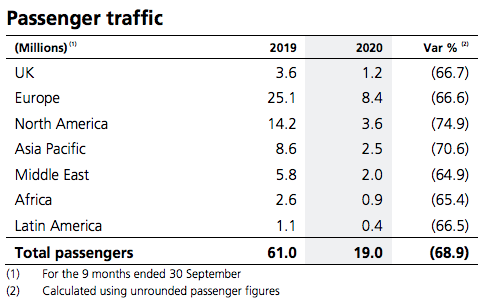UK. Heathrow Airport has forecast full-year passenger traffic of 22.6 million in 2020 and 37.1 million in 2021, well short of the 2019 figure of 81 million. The numbers have also been revised downwards from the June forecast of 29.2 million in 2020 and 62.8 million in 2021.
“The reduction is caused by the second wave of COVID and slow progress on introducing testing by the UK government to reopen borders with ‘high risk’ countries,” said Heathrow Airport as it revealed nine-month figures today.

With 19 million passengers in the first nine months (-68.9%), Heathrow has also slipped behind Paris Charles de Gaulle (19.3 million in the same period) as Europe’s largest airport, with Amsterdam Schiphol and Frankfurt close behind.
Heathrow said: “All three continental rivals have implemented testing regimes. The UK government has announced an intention to introduce testing for passengers from high-risk countries by 1 December to help restart the UK economy.”

Nine-month revenue declined by -58.7% year-on-year to £951 million, with Q3 revenue falling by -72% to £239 million. Heathrow’s pre-tax losses widened to more than £1.5 billion in the first nine months, compared to a loss of £76 million in 2019.
Retail revenue declined by -63.2% to £197 million, driven by reduced passenger numbers. Retail revenue per passenger increased +18.1% to £10.38 though the figure was distorted due to the sharp fall in passenger numbers.

Heathrow CEO John Holland-Kaye said: “Britain is falling behind because we’ve been too slow to embrace passenger testing. European leaders acted quicker and now their economies are reaping the benefits. Paris has overtaken Heathrow as Europe’s largest airport for the first time ever, and Frankfurt and Amsterdam are quickly gaining ground. Let’s make Britain a winner again. Bringing in pre-departure COVID tests and partnering with our US allies to open a pilot airbridge to America will kickstart our economic recovery and put the UK back ahead of our European rivals.”
The airport company said that liquidity at the end of September had been boosted further in October to £4.5 billion. “Cash reserves are sufficient for the next 12 months even under an extreme scenario with no revenue, and well into 2023 under our current forecast.”











